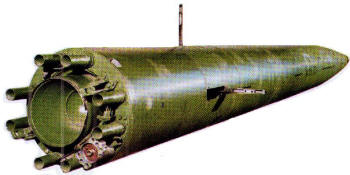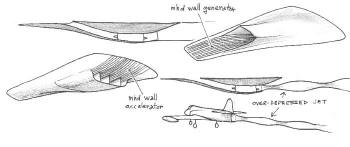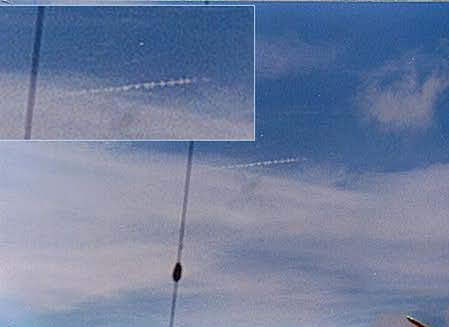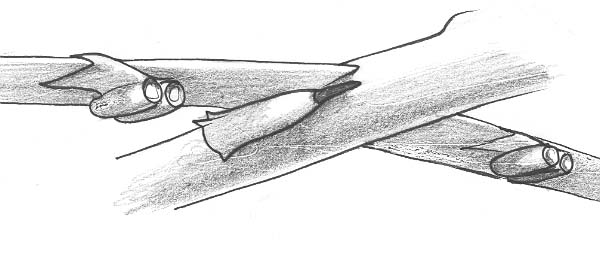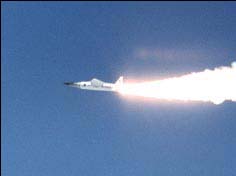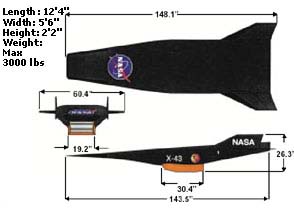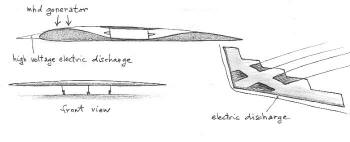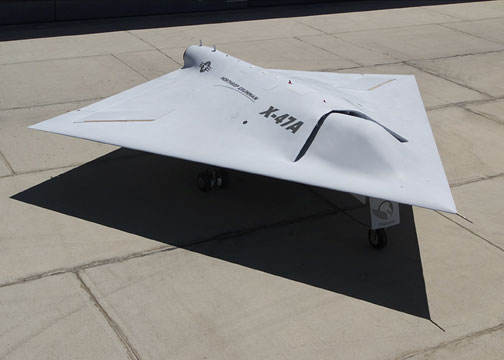|
The Letter
Introduction
The question is: "how far have they reached?". We hold accurate information about the American black programs linked with hypersonic planes, be it the satellisable Aurora spy craft or a hypersonic long range bomber for which the B2 is but a cover-up. Technical data in our possession allow us, in this particular case, to sustain our assertions.
These technologies were directly derived
from the analysis of the wreck retrieved at Roswell, which was a
hypersonic space shuttle and not an interstellar vehicle. We deplore
the fact that this reverse engineering has only been applied to
military ends, since these techniques could have found better use,
the one as a completely re-reusable space launcher - much more
efficient and cheaper than the customary rockets - the other as a
hypersonic commercial plane.
I shall ad that once antimatter has been produced in this way, it can farther be used to produce more. No nuclear explosion is needed at every start. However this technology lays in the hands of humanity incredibly more destructive bombs than the most powerful thermonuclear weapons presently available. It also generates a potential straightforward war hazard through the fact that very small quantities of antimatter can be stocked in crystals under very stable electrostatic confinement; this allows the production of tiny bombs - "bucky balls" - , the size of an egg, thermal shield included, of 40 ton TNT power.
Thanks to their relatively limited power and the fact that no waste is produced, these bombs could readily be used. Instead of dropping high power bombs on isolated targets, which would throw up great quantities of pulverulent matter into the high atmosphere and generate nuclear winter effects, it would be possible to scatter a great number of these mini antimatter bombs and cause equal damage, whilst avoiding that the dust should rise at high altitudes and generate a nuclear winter.
We believe that the US already possess a
considerable number of such weapons with which they would be capable
of reducing whole countries to ashes, and we fear that these devices
will soon be discreetly brought into action on more restricted
scales. This takes us far out of sight of the positive applications
of which Humanity could benefit from such a technology and thus
produce, as Dr. Greer rightly puts it, "flowering deserts".
Inversely, any system composed of atoms
could be converted into neutral waste such as helium, the typically
ideal waste. If we survive the next century, this is the picture of
our future technology. If such a set of techniques were completed
with a more comprehensive approach of biology then that which is
practiced on Earth today, the Human being would have the keys of a
Golden Age within arm's reach.
This is the technique used by UFO's when
they hover without any air displacement. In our opinion this can
only be understood via an important paradigm shift, a different way
of comprehending space and matter. But this is still speculative and
we suggest also coming back to it farther on. Anti-gravity control
could obviously be applied to civilian transportation, but far
beyond this, we think it would open the way to outer space travel.
Here again, we shall postpone the subject to the end of this paper.
We are skeptical as to the compatibility of such techniques with soft technologies within reach of amateurs and moderately sized laboratories. Such developments may, to our mind, only be envisaged by large scale laboratories with considerable funds for which a million dollar prize would seem but a derisory sum compared with the cost of such research. Consequently, laboratories of that size would inevitably be part of the military-industrial lobbies.
At best would the supporters of such a
project be rewarded with interesting theoretical ideas, but no
exploitable practical results. Such is our opinion, but of course we
may be mistaken.
The elements we are in a state to
produce are related to underwater high velocity propulsion and
construction of very long range hypersonic planes, both these
techniques being based on what is called magneto-hydro-dynamics, or
MHD.
In both cases, research teams came up against the fact that gases at "technological" temperatures, even when seeded with low ionization potential substances such as cesium, are not sufficiently electrically conductive. Below 3000°K, their electric conductivity is too low. The Russians have led this technique of MHD electricity production as far as possible with their U-25 generator, which burns a mixture of hydrocarbons and pure oxygen.
But this civilian oriented research was finally abandoned. Another trial took place where two-temperature gases were used (in which the electron gas has a higher temperature than the atom gas). This was not possible in a molecular environment which contained a lot of carbon dioxide (as a result of combustion). Indeed, this molecule is readily excited by the chocks with electrons. The result was a great loss of energy through radiation (radiative un-excitation).
This two-temperature system was thus limited to closed cycles where the conversion fluid was a rare gas: helium, seeded with cesium, used to cool down the heart of a reactor working at high temperature (1500°K). Let us point out that these reactors were neither built nor tested. Atomic scientists only thought they might be constructed and, thank God, they never were.
They also grasped that military MHD was of prime strategic importance and they launched an intense disinformation campaign, at home and abroad, to lure researchers away from what they declared to be a dead end subject. I hold this information from the fact that I was closely implied , since 1965, in French civilian MHD projects. I built a Faraday linear generator, based on a combustion shock tube, producing a power of several megawatts during 200 microseconds; with a two tesla magnetic field.
The Velikhov instability having been overcome, we succeeded in obtaining the first two-temperature stable running conditions, and this was presented at the 1967 Warsaw international colloquium. But notwithstanding this success, in the early seventies, in our own country as in others, this research was abandoned.
It is worth mentioning that our team obtained a gas blast speed gain of 5,500 m/s over a distance of less than 4", with argon fluxes at 10,000°K input into a Faraday accelerator at 2,750 m/s under a one bar pressure. But at the time nobody in France realized the military implication of what was to become, elsewhere, an MHD propulsion with high specific impulse.
Besides this novelty, representatives of various countries, American researches included, (the colloquium had been organized by J.F. Louis of AVCO), deplored the loss of interest of their governments. And yet we were ignorant of the fact that, three years earlier, the Americans had operated their first MHD torpedoes at 1,000 knots; we got wind of this many years later.
Today, in countries possessing leading technology, propeller torpedoes have been abandoned since exactly thirty years. The powder rocket propulsion was soon found to be more efficient and gave rise to such machines as the American Supercav or the Russian Sqwal.
The russian
Sqwal rocket torpedo (250 knots) The British today possess a similar weapon, the Spearfish. In these torpedoes, hot gas is ejected from the machine's nose and vaporizes the neighboring sea water. The torpedo then moves in a sheath of water vapor; the resulting friction reduction allowing speeds of 200 to 250 kn. Course control is achieved through the protruding pole which telescopes out of the nose after launching.
Steering is obtained by modulating the exhausts of nozzles which encircle the main propulsion nozzle and are fed by the forward situated gas generator. Today however are such machines quite out of date, even though countries such as France do not even have them yet. American and Russian MHD torpedoes also have a solid propellant rocket engine. The divergent works like an MHD convector, producing a large amount of electric energy.
This energy feeds a wall accelerator of which, for the sake of lightness, the principle description is appended. Such a system sucks the water in very strongly; hence is the viscous drag concept no longer appropriate since the wake is not only suppressed, but even reversed; which opens the path to very high speeds. Such speeds, reckoned today to be able to reach about 1,600 to 1,900 kn., enable the torpedoes to reach the targets in matters of seconds.
It is easy to see the major strategic asset brought to any nation possessing these torpedoes, since it would enable the destruction, in a few seconds, of the enemy's strategic nuclear submarines, which are the most dangerous of all weapons. They are generally positioned as close as possible to their potential targets in order to reduce the range of the ballistic flight, hence the chances of interception. In fact, the destruction of these missile loaded submarines would probably be the very first act of war of any nation with a high technological level of equipment.
The Chinese do not possess such an equipment yet. In 1996, the Russians attempted to make a demonstration of their machine nicknamed "the Fat One", of a one meter caliber, because they were hoping to sell them the torpedoes. Such a technology transfer would, in the long run, have meant a great menace to world security and, informed of the transactions, the Americans boarded and sank the Koursk which was due, in presence of a Chinese general, to make the demonstration.
Fearing this should be discovered, the Russians closed all of the submarine's hatches (by remote sonar order issued from the Peter the Great cruiser, flagship of the maneuvers), letting the entire crew perish and recovering the wreck later.
But the examination of the Roswell vehicle was to yield a much better solution, which would lead to the Aurora machine, which took its first flight in 1990 at Groom Lake. This very clever craft can take off by its own means, pick up speed and altitude, reach 6,000 kn. at 180,000 ft., then become sattelised with conventional rockets. Two very different successive operating modes are then called upon.
At the start, Aurora - of which Ajax, the Russian version designed by Fraistadt, was never built through lack of funding - looks like a conventional jet plane. Four turbo-reactors without post combustion are suspended under a very cambered wing with a completely flat top and a sharply lifted "duck tail" trailing edge.
Aurora in subsonic
and moderate Mach flight Aurora then reaches Mach 3 and the motor air feed changes. The bottom air intakes close up. The plane then flies in low pressure air which ionizes more easily. An air inlet opens on the top side, in front of which a set of parallel electrodes form an MHD wall generator.
Since this section works as a generator, the air is slowed down and re-compressed (by Lorenz forces). A continuous slowing down then takes place, without shock waves and with moderate heating, to such a point that the gas can be directed to the conventional turbo-reactor air intake, even though the plane flies at 6,000 kn. (11,400 km/h) at about 180,000 ft (54,000 m.) altitude. Very high tensions are generated by the Hall effect. In these parietal converters, the Americans use superconductor systems developing 12 teslas.
The Velikhov instability is mastered by magnetic confinement. The high voltage is used to create a plasma cushion which protects the leading edge. The electric power is next used to enhance the specific impulse thanks to a wall accelerator located aft of the nozzle outlets (MHD by-pass system). This is then of the "semi guided" type.
Aurora, hypersonic
flight It is designed to function with a fixed expansion coefficient at a given altitude. At lower altitudes, the expansion of the jet is too strong and it then exhibits a succession of knots and bumps, typical of "over-depressed" jets.
classical
over-depressed jet This explains the mysterious photograph taken near Groom Lake, where the plane, seen exceptionally in daylight, had not yet reached its adaptation altitude.
photograph of Aurora
jet Aurora's lift is obtained through the generated shock wave on which the plane surfs; it is a wave rider. But Aurora is not meant to function that way a long time because the formation of this shock wave generates a drag which entails a waste of energy. Rockets enable the machine either to become sattelised at an altitude of 250,000 ft., i.e. the atmosphere's limit, or to execute ballistic leaps, like a pebble bouncing on a water pond.
Under those condition it becomes a kind of pilotable semisattelite, such as the well known silver surfer. The total plasma envelope makes it also completely stealthy. Once sattelised at a speed of 15,000 kn. (28,500 km/h) it can reenter at a very slight angle of incidence without the need of a degradable thermal shield; the whole surface then works as an MHD generator.
The high tension produces a forward protecting plasma cushion; the energy being dissipated mainly through radiation. When the plane returns to its base, the whole process is gone through in reverse order; and when approaching it is propelled like a conventional plane and can land on a normal runway.
Model of Aurora X-43A slung under the wing of a B-52,
and poised in front
of a large powder booster Notice that vertical tails contradicts stealthyness. But the cut nose corresponds to the real Aurora. This is a cover-up on technological progress. The civilian version of Aurora would not be a sattelisable spy plane, but a completely reusable launcher, much cheaper than the classical rockets which depend solely on the thrust of their motors to overcome the drag linked with the generation of a chock wave.
The shape causes eddies which prevent
the wing tip loss of lift to creep up towards the leading edge
(short after the war, this phenomenon caused the crash of the flying
wing designed by Jack Northrop). The B2's based at Whitman, supposed
to have cost $2 billion each, are just decoys. The real plane is not
subsonic and has neither cockpit nor any hoods above the four
motors. These are completely included in the wing, so as to avoid
the turbine vanes from being detected by radar's.
This system allows complete control over the gas flux and suppression of any shock wave and hence wave drag. If the latter were to remain, the plane could not fly a long time considering the energy wasted in creating it. This elimination of shock waves was obtained in 1997 and opened the path to the first antipodal flights.
In fact, on more than one item this bomber is more sophisticated than the Aurora. For instance, the electrical discharge at the leading edge has a better mastered geometry which gives rise to a real "virtual" leading edge.
Hypersonic long-range
bomber Thus the machine, which the B2 dissimulates, is able to take off from the US, reach any point on the globe, and come back and land again in the US all in one night and four hours, even if the target lies in the antipodes at 10,800 nautical miles (20,000 km).
Bombing assignments have been enacted in Europe and Afghanistan, the latter being mentioned as subsonic 40 hour flights, necessitating six in-flight refueling, most of which took place over Russia which the planes had to cross. Considering the vulnerability of a plane while refueling, who would be gullible enough to believe such a version?
Notice also that the B2's which are shown have no bunk of any kind to allow crew members to take some rest. Could any pilot remain seated for forty hours on an ejector seat? See on my web site http://www.jp-petit.com a file on the B2.
The X-47A American documents are generally mute about the speeds of these planes, but even if they were stealthy, one can hardly imagine the Americans constructing subsonic combat drones!
Towards the end of the 60's, the Americans considered working these systems by using low power atom bombs (1kt of TNT) as explosive. The pressures reached were so considerable that they managed, in this kind of "laboratory", to reproduce conditions similar to the Big Bang, matter then muting into antimatter. The energy production turned out to be one hundred times greater than what was expected. This was kept secret. The Russians and the Chinese later tried to re-enact those experiences, but they failed because of lack of superconductors of adequate quality.
If one excepts stationary flight without air blast, which comes under "antigravitation", and sharp angle turns, it appears that Americans have almost managed to reproduce, thanks to MHD, the behaviour of inter-atmospheric cruising UFO's. They are now attempting farther to develop this technology, which would give them access to star travel.
We do not know if they have made any significant progress in that direction, though some believe they have. If such were the case, this would jeopardize the future of humanity because extraterrestrials would probably not tolerate that such barbarians as we are should go and give neighbouring civilizations a pain in the neck.
The first trials of these entirely oversized bombs, too powerful for Earth tests, were done by sending them off to the Sun. To do this, very high specific impulse MHD propelled bombs have been launched on trajectories at a wide angle to the Ecliptic plane in order to get merged with a known family of comets. Trials were continued with shots on Jupiter.
There again, the bomb modules were directed in such a way as to be mistaken for cometary debris. Initially loaded on board the military Atlantis shuttle, the modules were conveyed on site by an MHD propelled cargo which was then self-destroyed. The modules created a magnetosphere which simulated cometary degassing. They penetrated Jupiter's high atmosphere at 100 km/s thanks to their MHD shield system. Thermonuclear compressed antimatter synthesis, followed by instantaneous explosion caused the impacts to be mistaken for comet fragments.
The periodic return of this swarm of fragments, the size of comets or asteroids and thus undetectable at any greater distance than that of Jupiter, might cause some problems. Would aliens have delivered to the Americans means of accelerating their scientific and technical know-how in order to enable them to master the destruction of such objects between 2020 and 2030? Would the Roswell wreck have been a fake, purposely abandoned to trigger off this acceleration?
Every hypothesis may be considered. One must bear in mind that if such a risk were to exist it would be necessary to launch on a collision course with an object moving at 40 km/s; a conventional propulsion would be useless because the shot would next have to turn around to travel in convoy with the target. It would then have to bore a pathway with an antimatter spurt of several kilometers to go and explode a payload of several thousand megatons at the centre of the object in order to transform it into debris each less than one meter in diameter, which would burn out in the atmosphere. Are the shots fired at Jupiter and Io and Europa part of such a plan?
This model consists of a two-fold universe or double-universe. Australian researchers Foot and Volkas today follow a similar path, calling it "mirror-universes" (papers published in Physics Review). We have shown that the "apparent mass" of the "twin universe" was negative, i.e. twin matter repels ours while two particles of twin matter attract each other, in accordance with Newton's law. This repulsion explains the re-acceleration of the expansion of our universe, while it slows down the expansion of the twin.
One American research team is working on an idea based on attempting locally to modify the value of the speed of light; the "warp driving concept". Our approach is different and far more advanced. With the help of aliens, it has taken us years just to begin understanding how it works and it would require pages to describe. In principle, the vehicle's mass must be transferred to the twin universe.
When this operation takes place near the Earth, the latter becomes invisible to the craft but acts on it as a negative, repulsive mass. If the stations in our universe and in the adjacent region if the twin are rapidly alternated, this is not detected by an observer, however in one phase the vessel drops under the Earth's attraction, while in the other it rises under the Earth's repulsion. Globally this amounts to an apparent cancellation of the vessel's weight, whichever it's mass may be.
This is our interpretation of what
people call anti-gravitation. We do not know whether aliens have
given earthlings the tip about those techniques.
We care to know. Becoming conscious, at last, that they are not alone, would men acquire some wisdom and, using the technology which makes it possible, turn their planet into an Eden?
|
